 ] Title Type Year
] Title Type Year Computers & Security, vol. 38, Elsevier, pp. 14-27, OCT 2013. DOI
Abstract
Any deliberate or unsuitable operational action in control tasks of critical infrastructures, such as energy generation, transmission and distribution systems that comprise sub-domains of a Smart Grid, could have a significant impact on the digital economy: without energy, the digital economy cannot live. In addition, the vast majority of these types of critical systems are configured in isolated locations where their control depends on the ability of a few, supposedly trustworthy, human operators. However, this assumption of reliabilty is not always true. Malicious human operators (criminal insiders) might take advantage of these situations to intentionally manipulate the critical nature of the underlying infrastructure. These criminal actions could be not attending to emergency events, inadequately responding to incidents or trying to alter the normal behaviour of the system with malicious actions. For this reason, in this paper we propose a smart response mechanism that controls human operators’ operational threats at all times. Moreover, the design of this mechanism allows the system to be able to not only evaluate by itself, the situation of a particular scenario but also to take control when areas are totally unprotected and/or isolated. The response mechanism, which is based on Industrial Wireless Sensor Networks (IWSNs) for the constant monitoring of observed critical infrastructures, on reputation for controlling human operators’ actions, and on the ISA100.11a standard for alarm management, has been implemented and simulated to evaluate its feasibility for critical contexts.
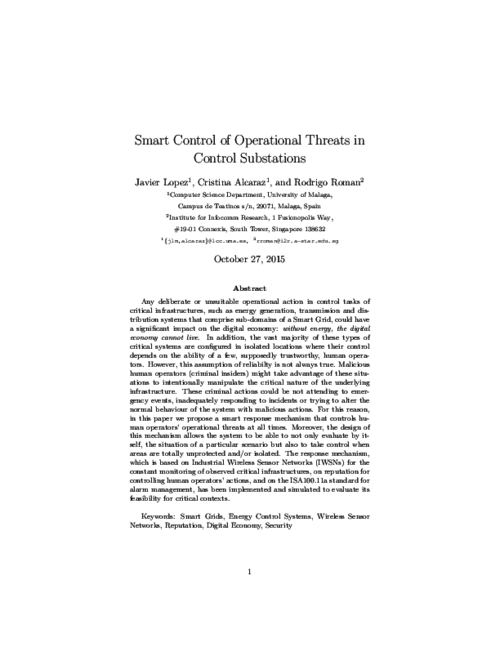
Computer Standards & Interfaces, vol. 27, no. 3, Elsevier, pp. 489-499, 2005.
Abstract
Organizations need to develop formally analyzed systems in order to achieve well-known formal method benefits. In order to study the security of communication systems, we have developed a methodology for the application of the formal analysis techniques, commonly used in communication protocols, to the analysis of cryptographic protocols. In particular, we have extended the design and analysis phases with security properties. Our proposal uses a specification notation based on one of the most used standard requirement languages HMSC/MSC, which can be automatically translated into a generic SDL specification. The SDL system obtained can then be used for the analysis of the addressed security properties, by using an observer process schema. Besides our main goal to provide a notation for describing the formal specification of security systems, our proposal also brings additional benefits, such as the study of the possible attacks to the system, and the possibility of re-using the specifications produced to describe and analyse more complex systems.
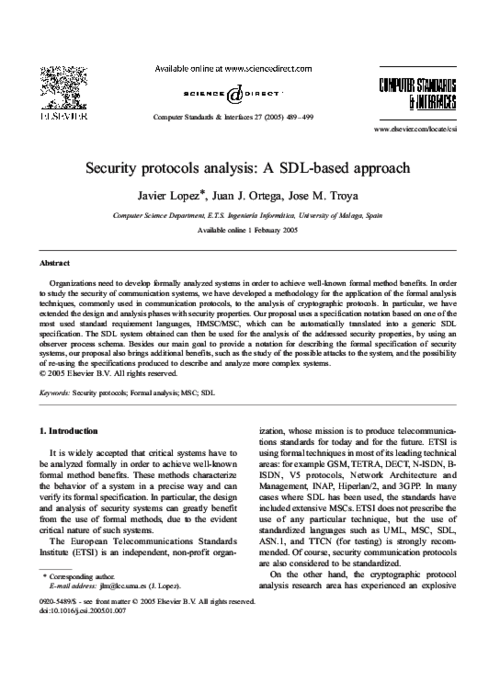
III Reunión Española de Criptología (III REC), pp. 133-138, Noviembre, 1994.
Computer Standards & Interfaces, vol. 27, no. 5, Elsevier, pp. 467-478, Jun 2005. DOI
Abstract
A challenging task in security engineering concerns the specification and integration of security with other requirements at the top level of requirements engineering. Empirical studies show that it is common at the business process level that customers and end users are able to express their security needs. Among the security needs of Internet applications, authentication and authorization services are outstanding and, sometimes, privacy becomes a parallel requirement. In this paper, we introduce a methodology for the specification of security requirements and use a case study to apply our solution. We further detail the resulting system after extending it with an Authentication and Authorization Infrastructure.
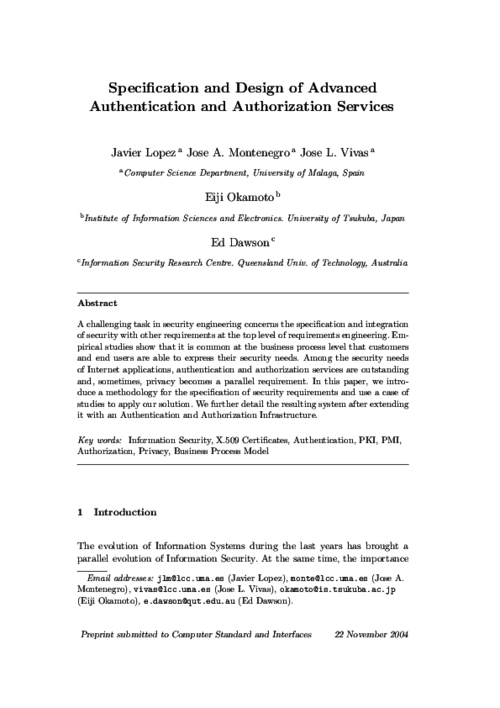
X Symposium Nacional de la Unión Científica Internacional de Radio (URSI’95), pp. 147-150, Septiembre, 1995.
Third International Conference on Ubiquitous Intelligence and Computing, LNCS 4159, no. 4159, Springer, pp. 977-987, August, 2006.
Abstract
The increased heterogeneity and dynamism of new computing paradigms and especially of ubiquitous computing models is boosting the need for auto-configurable systems. In these new scenarios, heterogeneity and dynamism are inherent properties and applications are built by aggregating distributed information and services that are not under the control of a single entity. Furthermore, the current trend towards distributed computing poses important problems related to the need to transmit large amounts of data between the distributed nodes of the computing system; the control over the information; and the flexibility to adapt to heterogeneous client requirements. These characteristics are difficult to manage by traditional computing models. For these reasons, the mobile agent paradigm is gaining momentum and the interest of researchers and industry in this paradigm is increasing. In this paper we present a solution to provide a secure and auto-configurable environment for mobile agents in ubiquitous computing scenarios. Our approach is based on two main building blocks: trusted platforms and profiles.
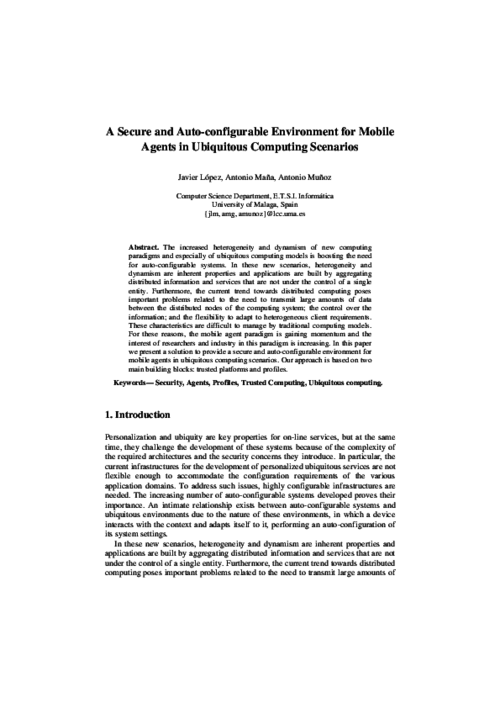
Revista SIC: Seguridad en Informática y Comunicaciones, vol. 38, pp. 1-5, 2001.
2nd International Workshop on Security Privacy and Trust in Pervasive and Ubiquitous Computing (SecPerU’06), IEEE Press, pp. 1-6, June, 2006.
Abstract
The extraordinary growth of the Information Society is originating a high dependency on ICT. This provokes that those strongly interrelated technological infrastructures, as well as the information systems that underpin them, become highly critical, since their disruption would lead to high economical, material and, sometimes, human loss. As a consequence, the protection of these Critical Information Infrastructures is becoming a major objective for governments and companies. In this paper, we give an overview of the main challenges and open research issues on Critical Information Infrastructure security, and introduce an on-going research project that, using wireless sensor networks as an underlying technology, is dealing with those problems. Our research project focuses on the development of protection, control, evaluation, maintenance and verification mechanisms, integrated into a secure service-oriented architecture.
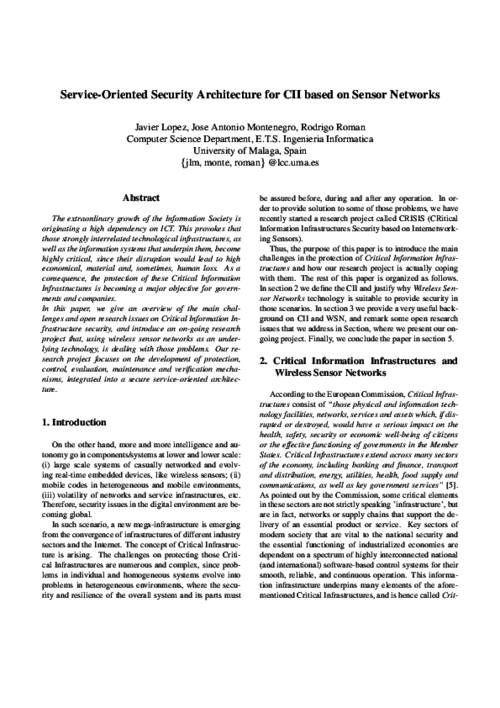
Online Information Review Journal, vol. 27, no. 3, Emerald, pp. 147-159, 2003.
